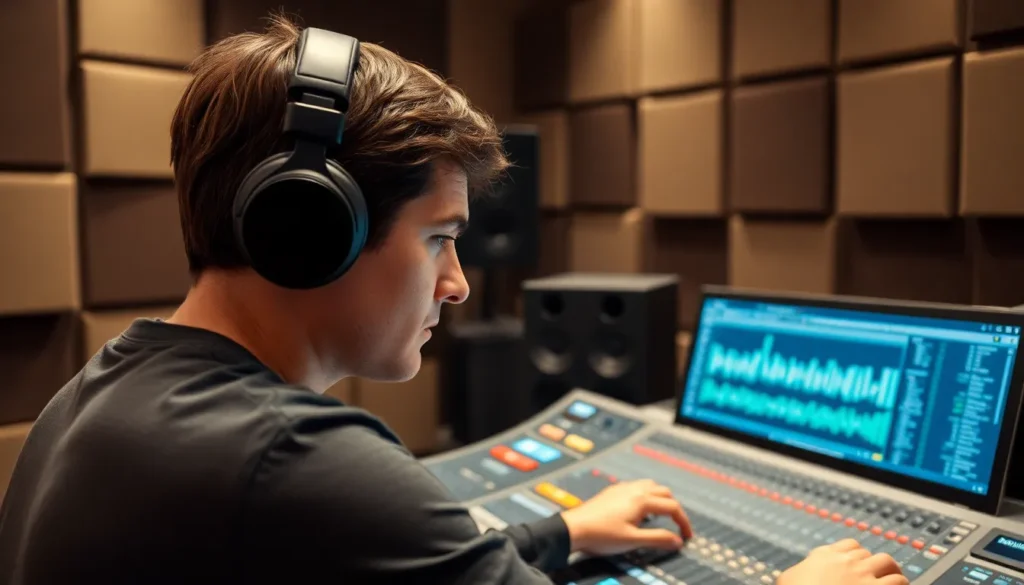Table of Contents
ToggleIn the world of audio production, clarity is king. But what happens when competing sounds go head-to-head like two heavyweight champions? Enter audio ducking techniques, the unsung heroes of sound mixing that swoop in to save the day. Picture this: a smooth voiceover battling it out with a catchy background track. Without ducking, it’s chaos. With ducking, it’s harmony—like a well-choreographed dance party for your ears.
Overview of Audio Ducking Techniques
Audio ducking techniques adjust the volume levels of background sounds to enhance the clarity of foreground elements. Primarily, producers apply this technique to voiceovers and music tracks. When an individual speaks, the background audio lowers automatically, ensuring the voice remains prominent. This practice increases listening comprehension and keeps the audience engaged.
Several methods exist for implementing audio ducking. Sidechain compression is one widely used technique. By routing the background audio through a compressor, the volume reduces when the voice triggers the compressor. This method offers a smooth transition rather than abrupt changes in audio levels.
Another approach involves manual keyframing. Producers can automate volume adjustments at specific points in the audio timeline. While requiring more meticulous editing, this technique provides precise control over audio levels. It allows for creative decisions, tailoring the sound to fit the desired mood of a project.
Additionally, utilizing automated mixing consoles can simplify audio ducking. These consoles allow for real-time adjustments, resulting in an efficient workflow. As an alternative, software plugins designed for ducking can streamline the process, offering preset configurations for quick application.
Many audio professionals consider ducking an essential method in sound mixing. By ensuring clarity between competing sounds, this technique promotes a more enjoyable listening experience. Implementing these strategies effectively leads to higher production quality, meeting the demands of audiences.
Importance of Audio Ducking

Audio ducking plays a crucial role in achieving clarity in audio production. This technique ensures that primary vocal elements stand out against background sounds.
Enhancing Clarity in Audio Mixes
Clarity remains vital in audio mixes, especially for engaging listeners. Ducking techniques, particularly sidechain compression, lower the volume of background tracks when a voice is present. When implemented effectively, voices become more pronounced, allowing for effortless comprehension. By managing competing sounds, producers create a seamless listening experience. Adjusting the background audio not only enhances vocal prominence but also maintains the overall emotional impact of the piece. Users often notice improved listener retention due to clearer communication in the soundscape.
Balancing Multiple Sound Sources
Balancing multiple sound sources is essential in audio production. Ducking enables sound engineers to prioritize important audio elements, like dialogues, over less critical background sounds. By lowering the volume of music or sound effects, they maintain focus on key audio components. Clouding the mix with excessive noise detracts from listener engagement. Effective ducking techniques ensure a polished mix that supports storytelling and keeps the audience immersed. Additionally, they allow for dynamic adjustments, making soundtracks that adapt to varying contexts within the production.
Types of Audio Ducking Techniques
Audio ducking techniques enhance clarity by adjusting sound levels, ensuring important audio elements stand out. Several prominent methods cater to different needs in audio production.
Sidechain Compression
Sidechain compression remains a favored technique in audio ducking. It utilizes a compressor triggered by a specific audio signal, often a vocal track, to lower the volume of background sounds. When the voice is detected, the compressor reduces the level of music or other audio elements. This method helps maintain vocal prominence while keeping the background engaging. Producers often favor sidechain compression for its quick implementation and effectiveness in live settings or recordings. Many digital audio workstations (DAWs) support sidechain functionality, allowing for seamless integration within projects.
Manual Ducking
Manual ducking provides precise volume control over competing audio sources. Audio engineers adjust background track levels at specific points on the timeline to make the primary sound stand out. This method offers detailed control, allowing for tailored adjustments that suit the narrative flow. When dialogue emerges, the engineer can lower the background volume to enhance clarity. While manual ducking requires more effort, it ensures accuracy and a polished sound. Often, producers use this technique during mixing sessions for optimal results.
Dynamic EQ
Dynamic EQ functions as an advanced method for audio ducking. It employs equalization to target specific frequency ranges, reducing background sounds when necessary. In doing so, it minimizes interference with vocal elements without compromising overall audio quality. Producers often prefer dynamic EQ for its flexibility, as it can adapt to different audio contexts. This technique helps maintain the natural sound of the mix while selectively lowering unwanted frequencies. By using dynamic EQ, sound engineers achieve a cleaner mix, further enhancing the listening experience.
Applications of Audio Ducking
Audio ducking serves various functions across different audio contexts. Producers utilize these techniques to enhance the listening experience and maintain clarity.
Podcasting
Podcasting benefits significantly from audio ducking. By reducing background music when hosts speak, clarity improves. This method allows listeners to focus on the dialogue rather than competing sounds. Podcasters often rely on sidechain compression to automate this process, making production smooth and efficient. Additionally, some use manual adjustments for more precise control, ensuring seamless transitions between segments. As a result, audience engagement increases, making the content more enjoyable.
Live Event Sound
Live event sound systems employ audio ducking techniques to manage multiple audio sources. In dynamic environments, such as conferences or concerts, it’s crucial to prioritize speech over music or other background noises. Sound engineers apply sidechain compression to automatically lower the volume of background music when a speaker is on stage. This method enhances clarity, ensuring the audience hears important announcements and information. Effective use of ducking creates a more immersive experience for attendees, reducing distractions.
Music Production
In music production, audio ducking plays a key role in achieving a balanced mix. Producers often apply ducking between vocal tracks and instrumental layers, enhancing vocal prominence. Sidechain compression frequently facilitates this process, allowing vocals to shine without overwhelming other instruments. Manual ducking also offers precision for adjusting levels at specific song sections. By managing dynamics effectively, professionals create polished tracks that maintain listener interest, drawing attention to essential elements.
Mastering audio ducking techniques is crucial for anyone involved in audio production. These methods not only enhance clarity but also elevate the overall quality of the listening experience. By effectively managing competing sound sources, producers can ensure that vital elements like dialogue and vocals remain at the forefront.
Whether using sidechain compression or manual adjustments, the right ducking technique can significantly impact audience engagement. As technology continues to evolve, these tools will play an even more vital role in creating immersive audio environments. Embracing audio ducking is a step toward professional-quality sound that resonates with listeners and keeps them captivated.







